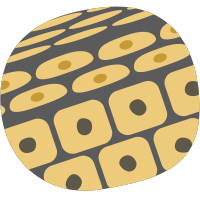
Dermal Cell News
Dermal Cell News is an online resource highlighting the latest research about wound healing, skin disorders, and dermal cancers.
Research Progress on Cell Cycle Arrest in Dermal Fibroblasts
[Cell Cycle] The authors summarize the endogenous and exogenous factors triggering cell cycle arrest in dermal fibroblasts and their underlying molecular mechanisms, with a particular focus on the roles of key signaling pathways such as p53, TGF-β/Smad, and Wnt/β-catenin.
Disease-Linked Regulatory DNA Variants and Homeostatic Transcription Factors in Epidermis
[Nature Communications] Researchers used massively parallel reporter analysis of 3451 single nucleotide variants (SNVs) linked to risk for polygenic skin diseases with disrupted epidermal homeostasis to identify 355 differentially active SNVs.
Neoadjuvant PD-1 and LAG-3-Targeting Bispecific Antibody and Other Immune Checkpoint Inhibitor Combinations in Resectable Melanoma: The Randomized Phase Ib/II Morpheus-Melanoma Trial
[Nature Medicine] In the Morpheus-Melanoma study, tobemstomig demonstrated a similar pathological response and improved safety profile versus nivolumab plus ipilimumab in patients with resectable stage III melanoma.
A Single-Cell and Spatial Genomics Atlas of Human Skin Fibroblasts Reveals Shared Disease-Related Fibroblast Subtypes across Tissues
[Nature Immunology] Researchers constructed a spatially resolved atlas of human skin fibroblasts from healthy skin and 23 skin diseases, with comparison to 14 cross-tissue diseases.
Impaired Migration and Lung Invasion of Human Melanoma by a Novel Small Molecule Targeting the Transmembrane Domain of Death Receptor P75
[EMBO Molecular Medicine] Screening a library of over 8000 drug-like compounds with an assay based on the transmembrane domains of death receptor p75NTR, scientists identified a novel small molecule capable of inhibiting p75NTR-mediated migration of human melanoma cells.
Underestimated Toxicity: UV Amplifies Low-Dose Cr(VI) Damage to Skin at Molecular and Tissue Levels
[Environmental Science & Technology] Integrated in vitro and in vivo models, researchers demonstrate that UV-induced redox cycling of Chromium(VI) generates reactive oxygen species, inducing DNA and protein cleavage, cytotoxicity, and skin barrier damage.
Single-Cell RNA Sequencing Reveals Transcriptomic Landscape and Potential Targets for Large/Giant Congenital Melanocytic Nevi
[British Journal of Dermatology] Scientists used a combination of single-cell and bulk RNA sequencing of lesional and non-lesional skin samples from patients with large/giant congenital melanocytic nevi (L/GCMN) and healthy skin samples. Patients with L/GCMN have a higher density of melanocytes and enhanced functions in melanin-synthesis-related processes.
Melanocyte Differentiation and Mechanosensation Are Differentially Modulated by Distinct Extracellular Matrix Proteins
[EMBO Reports] The authors exposed melanocytes to different extracellular matrix (ECM) proteins and varying substrate stiffnesses, and identified melanocyte-inducing transcription factor (MITF), a key regulator of melanocyte differentiation and function, as an ECM- and mechanosensitive transcription factor.
Indication Expansion Accelerates: First Patient Dosed in Melanoma Phase Ib/II Trial of Opamtistomig
[Nanjing Leads Biolabs Co., Ltd. (BioSpace)] Nanjing Leads Biolabs Co., Ltd. announced the first patient has been successfully dosed in a Phase Ib/II clinical trial evaluating Opamtistomig as monotherapy or in combination with other agents for the first-line treatment of advanced melanoma.
The Citrullinating Enzyme PADI4 Governs Progenitor Cell Proliferation and Translation in Developing Hair Follicles
[Science Advances] Researchers exploited the stereotyped hair follicle development to delineate the function of PADI4, an enzyme converting peptidylarginine to citrulline.
Selective Autophagy: A Potential Player in Cutaneous Wound Healing
[Advances in Wound Care] Understanding the basic mechanisms and intricate crosstalk underlying selective autophagy may facilitate the development of comprehensive strategies and therapeutic targets for wound healing.
Disrupted Cholesterol Biosynthesis and Hair Follicle Stem Cell Impairment in the Onset of Alopecia
[PloS One] Researchers explored the regulatory function of disrupted cholesterol homeostasis in the functioning of hair follicle stem cells and the cycling of hair follicles.
As the largest organ in the human body, the skin is implicated in a wide range of health conditions. Dermal Cell News is dedicated to covering it all. Our website, newsletter, and Twitter feed highlight research on tissue regeneration in the treatment of skin wounds, burns, cancers, and disorders. We also feature relevant job postings and upcoming events.

 Cancer Stem Cell News
Cancer Stem Cell News Cell Therapy News
Cell Therapy News Dermal Cell News
Dermal Cell News Endothelial Cell News
Endothelial Cell News ESC & iPSC News
ESC & iPSC News Extracellular Matrix News
Extracellular Matrix News Hematopoiesis News
Hematopoiesis News Hepatic Cell News
Hepatic Cell News Human Immunology News
Human Immunology News Immune Regulation News
Immune Regulation News
 Intestinal Cell News
Intestinal Cell News Mammary Cell News
Mammary Cell News Mesenchymal Cell News
Mesenchymal Cell News Muscle Cell News
Muscle Cell News Neural Cell News
Neural Cell News Organoid News
Organoid News Pancreatic Cell News
Pancreatic Cell News Prostate Cell News
Prostate Cell News Pulmonary Cell News
Pulmonary Cell News
